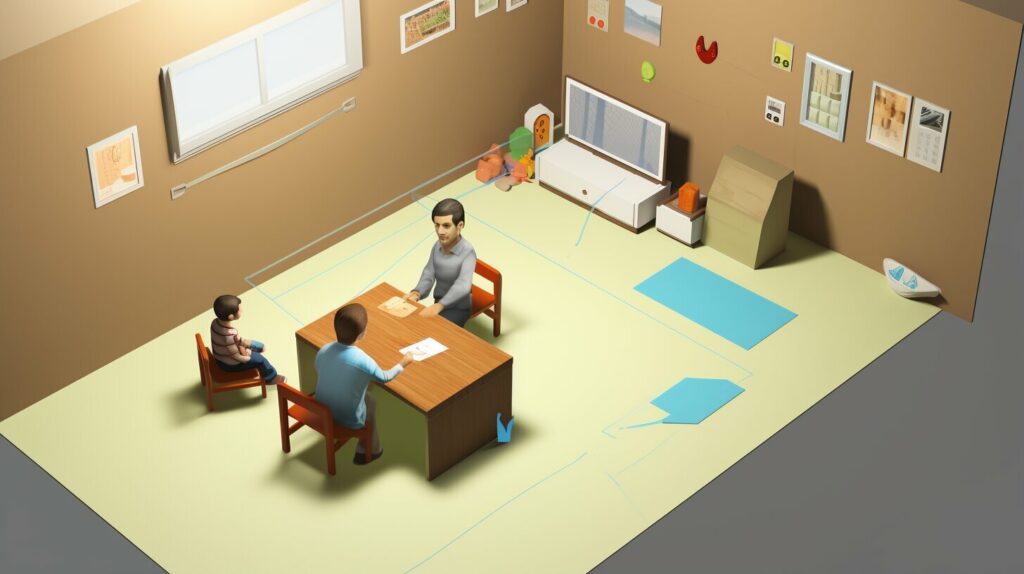Teaching your child about self control is an important step in their development. It can help them manage their emotions, make better decisions, and build positive relationships with others. However, explaining the concept of self control to a child can be challenging. How do you make it understandable and relatable?
In this section, we will explore effective tips and techniques for explaining self control to a child. By teaching them this essential life skill, you can empower your child’s growth and help them navigate their emotions and behaviors more effectively.
Key Takeaways:
- Self control is an important life skill that can benefit your child in many ways.
- Explaining the concept of self control to a child requires using simple language and relatable examples.
- Teaching self control to your child can be done through role modeling, setting clear expectations and boundaries, and practicing mindfulness.
- Reinforcing positive behavior is crucial to encouraging your child to continue practicing self control.
What is Self Control?
Before explaining self control to your child, it’s important to provide them with a simple and child-friendly explanation of what self control means. Help them understand that self control is about managing their impulses, thoughts, and actions in a way that is respectful and responsible.
Self control is like being the boss of your own body and mind. It means you can decide what you do and say, even when you really want to do something else. Self control helps you make good choices and stay calm in difficult situations. It’s like having a superpower that helps you be your best self.
Self control is not about being perfect all the time. Everyone makes mistakes, and that’s okay. The important thing is to keep trying to do better, even when it’s hard. With practice, you can improve your self control skills and become more confident and capable.

Why is Self Control Important?
Teaching self control to children is a crucial component of their personal development. Self control helps children make better decisions, resist temptation, and maintain healthy relationships with others. When children learn self control, they can better manage their emotions and behaviors, leading to greater success and happiness in life.
Research shows that children with strong self control are better equipped to handle stress and pressure, bounce back from setbacks, and achieve their goals. They are also more likely to have positive social interactions and stronger relationships with their peers, teachers, and parents.
By teaching your child self control, you are providing them with a valuable life skill that can benefit them in many ways. As they grow older, they will face many challenges, and the ability to manage their emotions and impulses will be critical for their success both in their personal and professional lives.

Teaching Self Control Through Role Modeling
One of the best ways to teach self control to children is by role modeling. Children learn by observing and imitating the behavior of those around them, especially their parents or guardians. When they witness you practicing self control, they are more likely to understand and implement it in their own lives.
When you encounter challenging situations, demonstrate how you use self control to manage your emotions and behavior. For example, when you feel angry, take a deep breath and count to ten before responding. Explain to your child that this moment of pause gives you time to think before acting, allowing you to make better decisions.
Another way to practice self control is by setting goals and working towards them. Show your child how you set attainable goals and manage your time effectively to achieve them. This teaches them that self control is not just about managing impulses, but also about planning and making choices that lead to success.

Remember, the key to teaching self control through role modeling is consistent behavior. Your child needs to see you consistently practicing self control to understand that it is an important life skill. Celebrate your successes and acknowledge your challenges, showing your child that self control is a journey, not a destination.
Encouraging Delayed Gratification
Delayed gratification is an important aspect of self control. When your child wants something right away, help them understand that waiting can be more beneficial in the long run. Explain the benefits of delayed gratification, such as achieving long-term goals and developing patience.
One fun way to practice delayed gratification is by playing a game. Set a timer for a certain amount of time and tell your child that if they can wait until the timer goes off before eating a treat, they can have two treats instead of one. This helps them learn that putting off a reward can lead to a greater payoff in the end.
| The Marshmallow Test |
|---|
The famous “Marshmallow Test” is a study that shows the benefits of delayed gratification. Children were left in a room with a marshmallow on a plate and told that if they could wait 15 minutes before eating it, they would get a second one. The study found that children who were able to wait for the second marshmallow had more success in various areas of life, such as academics and social interaction, later in life. |
Another way to encourage delayed gratification is by setting goals. Help your child set achievable goals, like saving up for a new toy or earning a reward for completing a task. This teaches them the value of working towards a goal and delaying immediate gratification for a bigger reward.

Remember to be patient and supportive while teaching your child about delayed gratification. This is a skill that takes time to develop, but the benefits are well worth it.
Setting Clear Expectations and Boundaries
To help your child develop self control, it’s essential to establish clear expectations and boundaries. This provides them with a clear understanding of what is expected of them and enables them to practice self control when facing challenging situations.
You can start by setting age-appropriate rules and explaining them to your child. For example, you may explain that hitting or yelling is not acceptable behavior and that there will be consequences if these rules are broken. By doing this, you give them the opportunity to practice self control by understanding their limits and following the established boundaries.
| Tip: | Ensure the rules are age-appropriate and clearly understood by your child. |
|---|---|
| Encourage your child to communicate with you if they feel that a rule is unfair or if they don’t understand it. This can create an open dialogue and encourage your child to comply with the rules set in place. |
Additionally, having predictable routines and consistent consequences for breaking rules can help your child develop self control. They will be able to anticipate the consequences of their actions and make choices accordingly.
By setting clear expectations and boundaries, you can empower your child to practice self control and make responsible choices that will benefit them in the long run.

Managing Emotions
Self control involves managing your emotions, such as anger, frustration, or excitement. Children can struggle with regulating their emotions, so it’s important to teach them techniques for handling their feelings.

One effective strategy is to teach your child deep breathing exercises. When they feel overwhelmed or upset, encourage them to take a few deep breaths and focus on their breathing. This can help calm their emotions and allow them to think more clearly.
Another method is to teach your child to take a break when they feel upset. Encourage them to take a walk, read a book, or engage in a calming activity. This can help them manage their emotions and avoid reacting impulsively.
“The greatest glory in living lies not in never falling, but in rising every time we fall.” – Nelson Mandela
Remember to be patient and understanding with your child as they learn to manage their emotions. Offer support and guidance as they develop this important self control skill.
Practicing Self Control Through Mindful Activities
Introducing mindfulness activities to your child can promote self control and emotional regulation. These activities encourage them to focus on the present moment and observe their thoughts and feelings without judgment. Here are some activities you can try with your child:
- Deep breathing exercises: Teach your child to take slow, deep breaths through their nose, hold for a few seconds, and exhale slowly through their mouth.
- Guided meditation: Play a guided meditation for your child or guide them through a meditation by using a calm and soothing voice to help them focus on their breathing and relax their body.
- Mindful coloring: Encourage your child to color mindfully, focusing on the colors, lines, and shapes of their picture without distractions.
- Sensory activities: Engage your child in sensory activities, such as feeling different textures, smelling different scents, or listening to calming music, to help them focus on their senses and feel grounded in the present moment.

Remember that practicing mindfulness is a skill that takes time and patience to develop. Encourage your child to set aside a few minutes each day to practice these activities and praise their efforts.
Encouraging Self Reflection and Evaluation
Teaching your child the importance of self reflection and evaluation is crucial in developing their self control skills. By taking a moment to think about their actions, they can become more self-aware and make better decisions in the future.
Here are some exercises you can do with your child to encourage self reflection:
| Exercise | Description |
|---|---|
| Gratitude Journal | Encourage your child to write down a few things they are grateful for each day. This helps them focus on the positive aspects of their life and develop a more optimistic outlook. |
| Mistake Analysis | If your child makes a mistake or behaves inappropriately, have them reflect on what they could have done differently. Ask them to come up with a plan for how they can handle similar situations in the future. |
| Self-evaluation | Encourage your child to evaluate their own behavior and actions. Ask them to rate themselves on how well they demonstrated self control in a specific situation and discuss ways they can improve. |
You can also model self reflection and evaluation yourself by talking to your child about your own experiences. Share stories about times when you made mistakes or handled situations poorly, and discuss what you learned from those experiences.
Encouraging self reflection and evaluation can help your child develop a growth mindset and become more resilient in the face of challenges.

Reinforcing Positive Behavior
Reinforcing your child’s efforts to practice self control is essential to help them develop this important skill. When your child demonstrates self control and makes responsible choices, praise them for their efforts. Use positive reinforcement techniques to motivate them, such as offering verbal praise, small rewards, or extra privileges. This positive feedback helps your child feel good about their progress and encourages them to continue practicing self control.
Remember to praise your child for their specific behavior, rather than making general statements. For example, instead of saying “good job,” you can say “I’m proud of you for taking a deep breath and controlling your temper when you were upset.” This highlights the specific behavior you want to reinforce and encourages your child to repeat it in the future.

It’s important to be consistent with your reinforcement and provide regular opportunities for your child to practice self control. Over time, your child will internalize this positive behavior and develop stronger self control skills that will serve them well throughout life.
Conclusion
Congratulations! You’ve learned valuable tips and techniques for explaining self control to your child. By teaching your child about self control, you’re helping them develop an essential life skill that can lead to success and happiness. Remember to provide a simple and child-friendly explanation of what self control means, and highlight its importance in making better decisions and maintaining positive relationships with others.
Demonstrate self control through role modeling, teach your child the benefits of delayed gratification, and establish clear expectations and boundaries. Help your child manage their emotions through mindfulness activities, encourage self reflection and evaluation, and reinforce positive behavior with praise and rewards.
Learning self control is a lifelong journey, so be patient, consistent, and supportive throughout the process. With your guidance, your child will develop the self control skills they need to navigate life’s challenges and achieve their goals. Good luck!
Can Mindfulness Techniques Help Teach Children Self Control?
Mindfulness techniques for children can be invaluable in teaching self-control. By explaining mindfulness techniques for children, they can develop invaluable skills to manage their emotions, make better choices, and remain calm in challenging situations. These techniques encourage children to be present, observe their thoughts and feelings, and respond consciously, ultimately fostering self-control for a well-rounded development.
FAQ
Q: How can I explain self control to a child?
A: Teaching self control to children can be done through various techniques such as role modeling, encouraging delayed gratification, setting clear expectations and boundaries, managing emotions, practicing mindful activities, encouraging self reflection and evaluation, and reinforcing positive behavior.
Q: What is self control?
A: Self control is about managing impulses, thoughts, and actions in a way that is respectful and responsible.
Q: Why is self control important?
A: Self control is important because it helps children make better decisions, resist temptations, and maintain positive relationships with others. It is a valuable life skill that can lead to success and happiness.
Q: How can I teach self control through role modeling?
A: By showing your child how you practice self control in your own life and explaining your decision-making process and emotional management, you can effectively teach them about self control through role modeling.
Q: How can I encourage delayed gratification?
A: You can explain to your child that waiting for something they want can have benefits, such as achieving long-term goals and developing patience.
Q: How can I set clear expectations and boundaries?
A: Help your child understand the importance of having rules and limits. Teach them how to recognize and respect these boundaries.
Q: How can I help my child manage their emotions?
A: Discuss the connection between self control and managing emotions. Teach them simple strategies to manage their emotions, such as deep breathing or taking a break to calm down.
Q: What are some mindful activities that can help with self control?
A: Introduce your child to mindfulness activities like deep breathing exercises, guided meditation, or mindful coloring to help them practice self control.
Q: Why is self reflection and evaluation important?
A: Self reflection and evaluation are important for developing self awareness and improving self control skills. Encourage your child to reflect on their choices and consider alternative ways to handle situations.
Q: How can I reinforce positive behavior related to self control?
A: Reinforce your child’s self control efforts by praising their responsible choices and using positive reinforcement techniques such as verbal praise, small rewards, or extra privileges.






